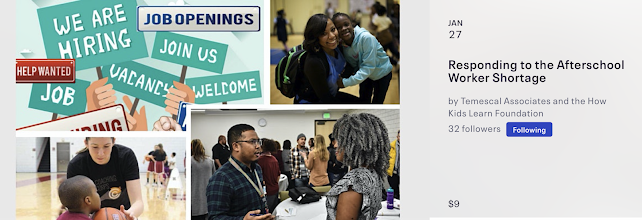 |
| Source: (Clockwise, Top to Bottom): Jill on Money, WINGS For Kids, The How Kids Learn Foundation and Coaching Corps |
By Sam Piha
Recruiting, hiring, and retaining afterschool workers have been long standing issues in afterschool programs. This is due to low wages, mostly part-time hours, the lack of opportunities for advancement, and the lack of job security due to the reliance on temporary grants and funding. (Many say that low wages are also the result of childcare being a “women’s profession,” as well as our society’s undervaluing of the education and care of children and youth).
Then the COVID-19 pandemic hit—and these issues were greatly exacerbated. They had resulted in programs closing, drastically reducing capacity, and adding stress to afterschool workers. Many of these challenges are not unique to the afterschool field- they are being experienced by those in education and a wide range of fields.
This is the first in a series of LIAS Blogs to address this issue. This blog is an excerpt from a larger, briefing paper entitled, Understanding the Shortage of Workers in Afterschool Programs developed by Temescal Associates. The full paper can be downloaded and read here.
“The most pressing problem facing afterschool is the nationwide shortage of workers.” – Michael Funk, Director of CDE Expanded Learning Division
In Afterschool Alliance’s Wave 5 survey of the field, conducted June 2-28, 2021, they found:
- 80% of program providers surveyed reported that they were concerned about finding staff to hire/staffing shortages (57% extremely or very concerned).
- 41% of program providers reported that advice on staff burnout and keeping teams engaged would be most helpful to their program.
- 57% of programs that reported that they planned to be open in the fall of 2021 said that being able to hire enough staff was of most concern to them.
Survey Conducted by East Bay Asian Youth Center of 13 Lead Agencies Providing Afterschool Programs to 76 Schools
What Factors Contribute to Average Daily Attendance Requirements Not Being Met?
- 85% Staff Shortage
- 70% Health & Safety Concerns
- 54% COVID-19
- 46% School Day Enrollment Decline
- 31% Seasonal Program Enrollment Withdrawal by Students
- 23% Other
- 85% Health & Safety Concerns
- 77% Preference for Full Time Employment
- 80% Unqualified Candidates
- 39% Compensation
- 39% Family Obligations
- 39% Preference for Employment in Other Industry
- 23% Other
“There’s great uncertainty about economics. Programs are losing resources and funding and really struggling to survive. We’re really concerned with what is happening in the field. Afterschool programs have been a lifeline for our kids, for our families and our communities during these desperate times.” – Jodi Grant, Executive Director, Afterschool Alliance
IMPORTANT TERMS AND DEFINITIONS
Afterschool - There are many terms that refer to school-based and community-based youth programs outside of the classroom. They include “afterschool,” “out-of-school time (OST),” “expanded learning programs (EXL),” and “youth programs.” For the purposes of this blog series, we will primarily use the term “afterschool” to refer to all these programs.
Afterschool Workforce - The expanded learning workforce is largely made up of people of color, in part-time employment with limited to no benefits. A 2012 study found that 69% of the afterschool workforce in California are people of color, 65% are female, and 69% are part-time workers.
Worker Shortage - This is when there are an insufficient number of qualified individuals in a particular occupation to meet the demand for workers. This is worsened when afterschool programs have problems retaining staff.
Equity - Equity is just and fair inclusion. An equitable society is one in which all can participate and prosper. The goals of equity must be to create conditions that allow all to reach their full potential. In short, equity creates a path from hope to change.
“The route to achieving equity will not be accomplished through treating everyone equally. It will be achieved by treating everyone justly according to their circumstances.” — Paula Dressel, Race Matters Institute
Actions at the Program Level vs. Policy/ Systems Level - “Programs are short-term interventions that create temporary improvements in the wake of challenges. Policies, on the other hand, are covenants we collectively choose to live by, as articulated in legislation and regulation.” For example, “programs can't eliminate the systemic injustices that any group faces. They can help people manage the effects of these injustices, but they don't overcome or cure them. Policies, conversely, actually shift the way communities and their members react and relate to one another, empowering people to improve their own well-being in a systematic way.”
Temescal Associates and The How Kids Learn Foundation will be conducting a webinar focusing on the nature of the current worker shortage, the challenges to afterschool programs and how best to respond to this as a field on Thursday, January 27, 2022 from 10:00am - 12:00pm (PST). To learn more and register, click here.








No comments:
Post a Comment